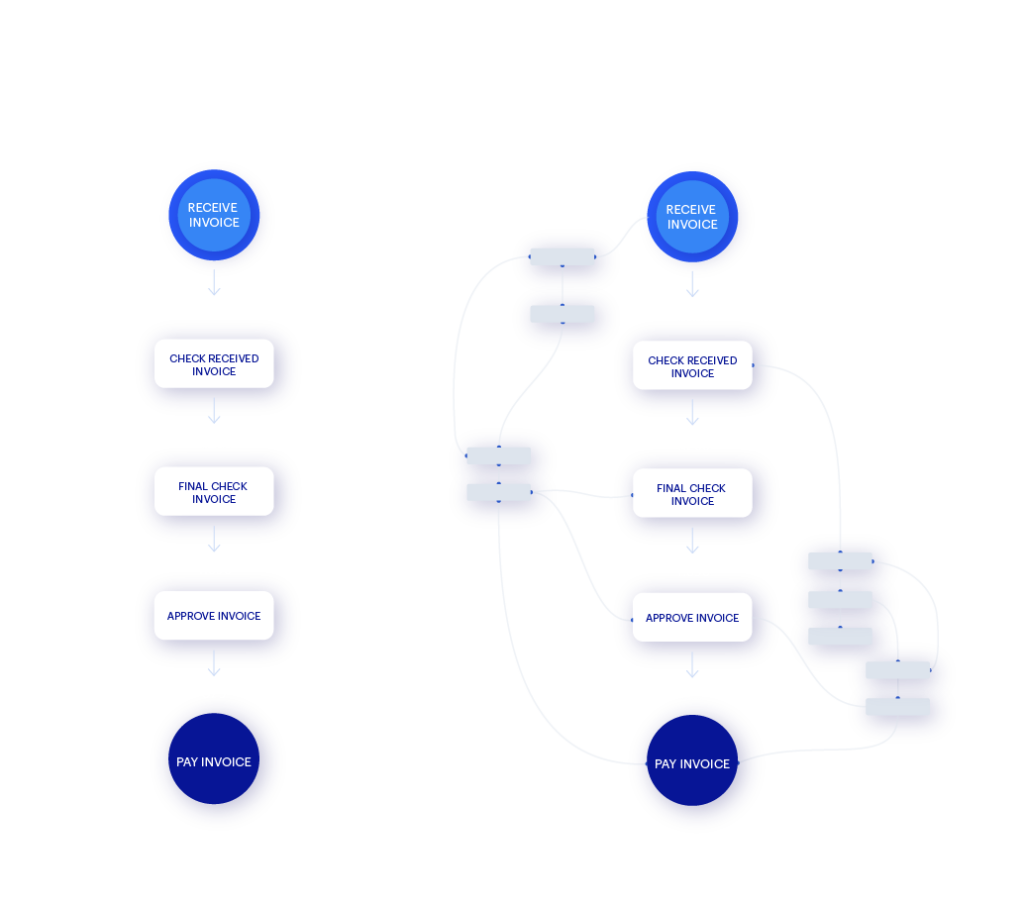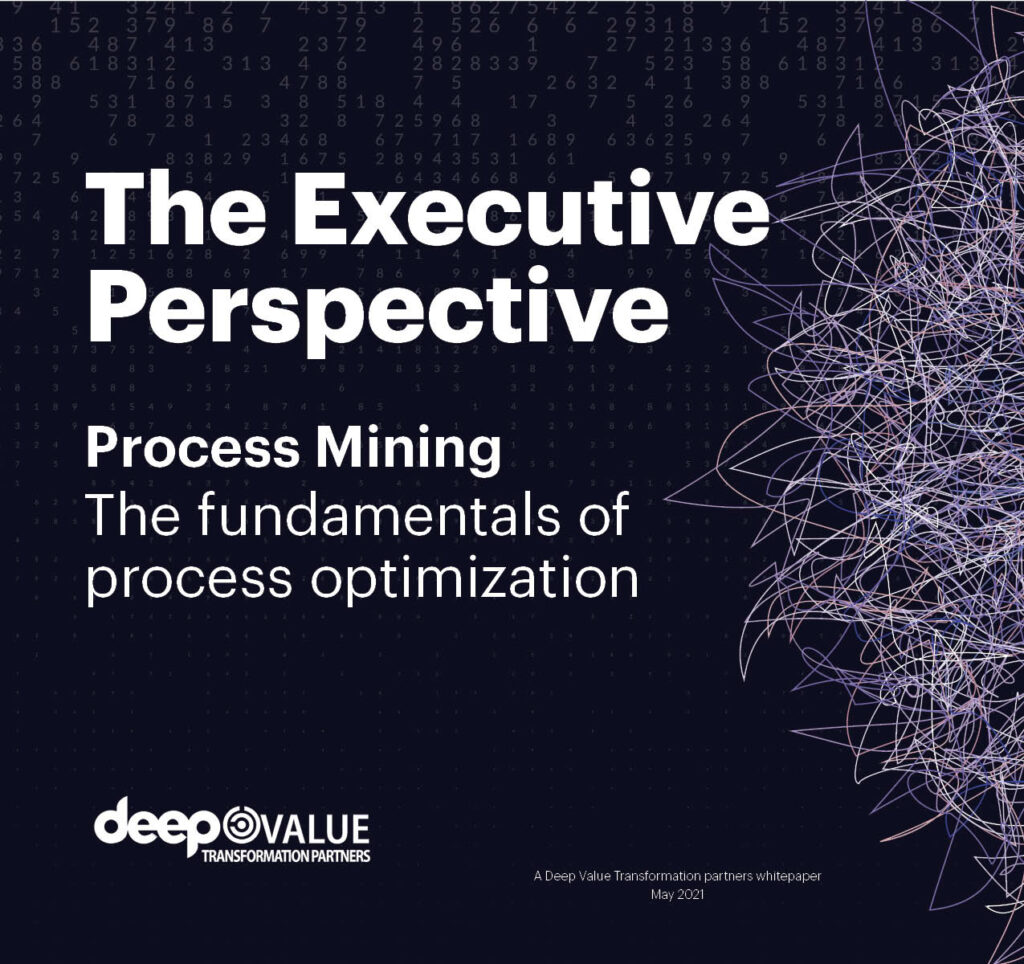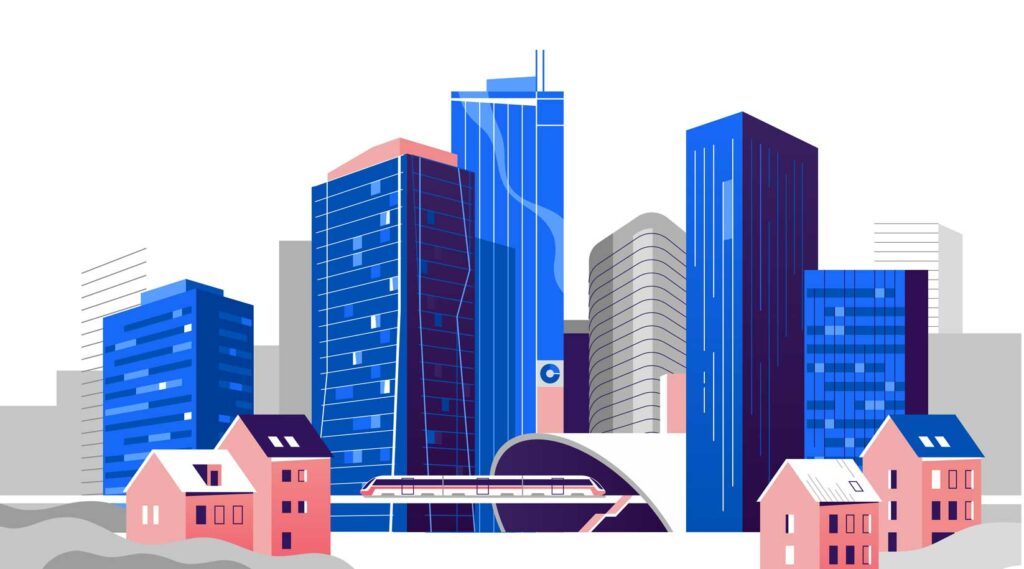Process mining is designed to identify and eliminate the gap between fiction and reality of business processes by unlocking knowledge available in your information systems. Process mining helps you monitor, analyze and improve your existing business processes by answering both compliance and performance-related questions.
The most compelling reason to consider process mining is that process inefficiencies are responsible for 25% of lost revenue. Process mining can help eliminate unnecessary steps in the processes and make them perform optimally.

Whether you want to optimize financial, manufacturing, or customer service operations, process mining benefits your entire organization.
The goal of process mining is to analyze the data of your activities from different perspectives and summarize it into useful information so that you are able to make the right decisions faster.
Process Mining vs Process Mapping activities
One of the biggest challenges in analyzing business processes is understanding how processes are actually performed. Process experts often design processes with the expectation that they will be truly executed by employees. However, process designs are incomplete and often not feasible in practice.
Analyzing processes is not new. Before data was easily digital available, people simply went through documents by hand or collected data from interviews to find useful information and inconsistencies. This traditional method of process analysis cost a lot of consultants, weeks of time, workshops, interviews, and a lot of money to get a picture of how things were going and what could be improved.
The results of this approach are subjective, incomplete, and often outdated by the time they are available. Furthermore, you miss the bigger picture of how the activities are having taken place. You miss the exceptions of the standard designed process because activities are rerun due to an error or a change in order. Let alone changes due to external factors such as new customer requirements or changes in regulations. It is impossible to have an overview of all these exceptions and deviations.
So what is Process Mining?
Process Mining offers many advantages over the traditional approach of data analysis and process management. Process mining is a technique for analyzing, monitoring, and improving processes in organizations. With process mining, we rely on the data produced by our process to quickly get an objective and complete picture.
Process mining works on the principle that when we interact with an IT system, whether there is a mouse click or a keystroke, it leaves a digital footprint. And based on these data and event logs, the process is reconstructed. In effect, you create a digital twin of the process.
An important advantage of process mining is that it provides objective, fact-based information because the reports you get are derived from hard data. For example, you can test, analyze and improve existing business processes with the help of process mining.
Process mining, therefore, starts with analyzing the data produced by your IT systems. This is then stored in so-called event logs. We connect the event logs from different systems so that we can follow your process from start to finish across different systems.

Necessary elements of Process Mining
The fundamental elements of an event log to perform process mining are a CaseID, Activity, and Timestamp. For example, the CaseID can be an order number or an invoice number. A timestamp tells you when a process started or when it ended. And finally, the activity, the description of your process steps. The names of activities are usually short and clear, such as invoice approved, or order shipped.
You can of course add more information to the event log to make a more detailed analysis. That allows us to ask questions such as:
- Why are orders not fulfilled on time?
- Where are the bottlenecks in my process?
- Which functions/employees are overloaded?
- Which activities and compliance checks are skipped?
and which employees cause this deviation.
An important advantage of process mining is that it provides objective, fact-based information because the reports you get are derived from hard data. With the help of process mining, you can make recommendations where the process can be improved, where we need to change activities, or how to redesign the process and which activities can be automated.
Why Process Mining is important
To respond to the accelerating pace of business transformation, you need to be able to react quickly and not create analytics that are outdated before they are complete. The accumulation of data means that your process analyses cannot be based on gut feelings: you need fact-based figures and evidence to back up your claims.
Save time and free up working capital
Traditionally, managing and optimizing processes has been a very labour-intensive area that requires a lot of time from experts in the organization. The growing demand for efficiency and the ability to clearly present results also affect BPM professionals. When the Process professionals finished the situation analysis, the data they used to support their assumptions has already changed, making the analysis useless.
When optimizing processes, collecting data is often the most time-consuming part. With process mining, you get a head start by automating the data collection part. The basis for understanding the operational situation in an organization is to understand what is actually happening, not what is supposed to happen. This is what you find out using process mining.

Locating process bottlenecks
Process bottlenecks are difficult to discover during process mapping workshops. Employees have a gut feeling of what could be wrong or inefficient, but they lack the fact-based evidence. They need the data to back their assumptions, and this is where process mining comes to the rescue.
Replacing opinions with facts
One of the main objectives of process mining is to see the big picture of an organization’s business processes and still be able to identify the causes of deviations, bottlenecks or process variations. With process mining we don’t have to settle for averages – we find out the reasons for undesirable behaviour or process progress.
To give an idea of what process mining yields for different types of organizations, we will give a few short examples.
What are typical use-cases for Process Mining?
Process mining is beneficial for many situations in organizations. The most common use cases for process mining are:
Process Optimization: Organizations can use process mining for faster and more accurate analysis of their processes. Performance data can be derived from the event logs and used to identify bottlenecks and cross-cost activities to optimize speed. Instead of wasting time understanding processes, use this time to take potential actions.
Process discovery for automation: Process mining helps identify process automation capabilities, continuously monitor how the automation is performed and how to adjust it. With process mining you can optimize your processes and increase the ROI of RPA by 44%.
Process simulation: Organizations can make future predictions by mining the processes with the data derived from event logs. The scenarios can be used to inform stakeholders and customers. For example, the customer can get an accurate estimate of when his or her mortgage application will be processed.
ERP implementation and migration: Process mining collects the data from your ERP database and automatically detects business processes, along with the flowcharts, the deviations from your As-Is process and the resources involved. This complete end-to-end insight allows you to immediately implement process improvements so that your new ERP system starts directly with streamlined processes.
Process compliance: Organizations can check if their actual processes comply with internal legislation and external regulations. For example, when purchasing products or services, different approvals are required based on the amount and type of product. Deviations and trends can be analysed so that organizations can take immediate action to reduce these deviations and ensure standardized processes.
Apply Process Mining to specific processes
The basic condition for analyzing a process in process mining solutions is data. The process must be digital in some form or recorded in an IT system. However, this does not mean that we only consider analyzing processes that take place exclusively in the computer. Production processes such as assembly also leave digital footprints when the production machines are controlled or monitored via a virtual system.
If such data is available, the analysis with Process Mining is possible. Below we have listed other process mining examples in the Financial, Supply Chain and Customer Service domain, in addition to the most common examples such as Order-to-Cash and Purchase-to-Pay.
4 steps to Process Mining
In this infographic, we have detailed the four steps you need to take to get started with Process Mining
Purchase-to-Pay (P2P) process
The accounts receivable department of many organizations are already completely digitized, if not automated. With tens or even hundreds of orders placed in the purchasing department every month, there is sufficient data available for effective process analysis. The concrete use cases are countless.
The purchasing process can be perfectly analysed with Process Mining to find out how framework contracts are complied with and where, for example, Maverick Buying takes place. Other common analytics include invoice verification, claims handling, purchase requisitions, and supplier performance.
Order-to-Cash (O2C) process
In the order-to-cash process, you need to analyse the end-to-end lead time or the lead time between process steps – check the lead time from the delivery of the product to the creation of the invoice, to identify the causes of late delivery.
To gain further insight of the order process, it is possible to zoom in on reducing the lead time by automating the change of customer orders or analyzing and benchmarking the amount of returned goods so the Order-to-Cash process can be further optimized.

Service Management process
Process Mining is used to increase insight and transparency of service management processes. Process Mining identifies the one-off and unwanted process steps and validates whether escalations of high-priority tickets are effective. Specific KPIs for service management are created, such as SLA compliance, Average Handling Time and First Call Resolution.
Production process
Although the manufacturing industry mainly works with tangible materials, virtual data is no less central. Machines and sometimes even entire factories are digitally controlled and monitored via systems and the logistics and order processes are managed. Process mining can reveal the inefficiencies within the production processes and reduce the lead time by 20%. In addition, it can focus on reducing rework by generating process mining alerts when production deviates from the standard settings of the production process.
Apply Process Mining to specific processes
If your business processes run sub-optimal, this can cost organizations a lot of money. Simply because you do not use the full capacity, because unnecessary mistakes happen or people perform unnecessary actions. Process mining provides insight into:
- How a process involving multiple departments actually works;
- Whether agreements of processes are fulfilled.
- Whether unnecessary actions are taking place.
Process mining can also provide insight into:
- Which supplier best fulfils its agreements.
- Which partners generate the most revenue and new business;
- Which teams or employees do not follow the agreed process.
Visualize processes, make findings and discover root causes
We as Deep Value are here to help you improve your processes in a data-driven way. We ensure that processes become transparent and that you can monitor them on a daily basis.
A typical Process Mining project with us consists of four incremental phases, data collection, process exploration, process improvement and process monitoring. This it is not a lengthy and expensive project. The project always has a positive business case, due to our accessible approach in applying Process Mining.
Are you curious about the impact process mining can have within your organization? Make sure to book a live demo here.




Leave a Reply